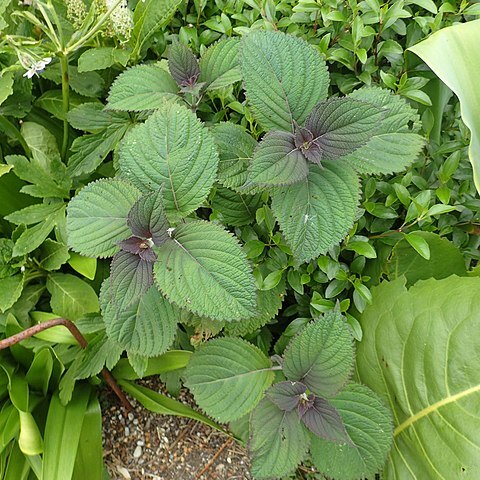Subshrubs erect, 0.6-2.6 m tall. Branches densely gray pubescent. Petiole 3-6 cm; leaf blade broadly ovate to sub-circular, 8-15 × 5.2-8.2 cm, adaxially pubescent especially on veins, abaxially glabrous, densely yellowish glandular, puberulent on veins, base rounded to shallowly cordate, oblique, margin mucronate-to serrate-crenate, apex abruptly caudate-acuminate. Spikes terminal and axillary, robust, 6-12 cm, pedunculate, densely gray pubescent; lower verticillasters widely spaced; bracts broadly ovate, ca. 3 × 3 mm, sparsely puberulent abaxially, margin ciliate, apex mucronate. Pedicel ca. 1 mm. Calyx campanulate, ca. 3.5 mm, pubescent, glandular outside, apex pubescent inside; teeth subulate-linear, apex linear; fruiting calyx tubular-campanulate, to 6.5 × 2.5 mm. Corolla yellow, ca. 6.5 mm, white villous, glandular outside, bearded annulate inside; tube ca. 4 mm, funnelform, to 2 mm wide at throat; upper lip emarginate; middle lobe of lower lip subcircular, margin erose; lateral lobes suboblong, rounded. Nutlets dark brown, oblong, ca. 1 mm. Fl. Jul-Oct, fr. Sep-Nov.
More
An erect shrub. It only has a few branches in the stem. The leaves are stalked. They are opposite. The leaves are 6-20 cm long by 2.8-13 cm wide. They are oval and taper to the tip. They have teeth along the edge. The base is rounded or heart shaped. The flowers are yellow. They occur in dense rings of many flowers. The fruit is a nutlet.
It is a temperate plant. In Nepal it grows between 1600-3000 m altitude. It grows in shady valleys and moist places in oak forests. in China it grows between 1,000-2,900 m above sea level. In Sichuan and Yunnan.
More
Shady ravines and moist places in oak forests; at elevations from 1,600-3,000 metres. Open cultivated areas, valleys, forest margins, thickets; at elevations from 1,000-2,900 metres.

